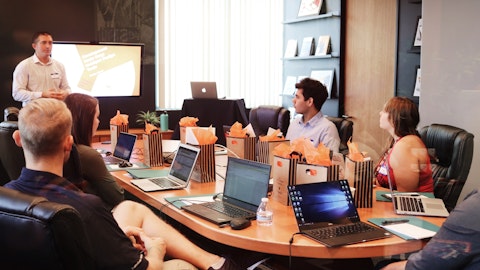The Kraft Heinz Company (NASDAQ:KHC) Q1 2023 Earnings Call Transcript May 3, 2023
Operator: Good day and thank you for standing by. Welcome to The Kraft Heinz Company First Quarter Results. At this time, all participants are in a listen-only mode. After the speakers’ presentation there will be a question-and-answer session. And be advised that today’s conference is being recorded. I would now like to hand the conference over to Anne-Marie Megela, Head of Global Investor Relations. The floor is yours.
Anne-Marie Megela: Thank you, and hello, everyone, and welcome to our Q&A session for our first quarter 2023 business update. During today’s call, we may make forward-looking statements regarding our expectations for the future, including related to our business plans and expectations, strategy, efforts and investments and related timing and expected impacts. These statements are based on how we see things today, and actual results may differ materially due to risks and uncertainties. Please see the cautionary statements and risk factors contained in today’s earnings release, which accompanies this call as well as our most recent 10-K, 10-Q and 8-K filings for more information regarding these risks and uncertainties. Additionally, we may refer to non-GAAP financial measures, which exclude certain items from our financial results reported in accordance with GAAP.
Please refer to today’s earnings release and the non-GAAP information available on our website at ir.kraftheinzcompany.com, under News and Events for a discussion of our non-GAAP financial measures and reconciliations to the comparable GAAP financial measures. Before we begin, I’m going to hand it over to our CEO, Miguel Patricio, for some brief opening comments.
Miguel Patricio: Thank you, Anne-Marie, and thank you, everyone, joining us today. We are proud, proud and confident. We are so confident that we are raising our guidance on EBITDA and earnings. We are so confident that we are increasing our investments in marketing and in R&D by $100 million to $150 million versus budget, which represents a solid double-digit growth versus previous year. These results are not a coincidence. They are because of our confidence. We have been consistently saying that we’ll grow through emerging markets, and we grew 23% this quarter. We’ll grow throughput service globally, and we grew about 29% this quarter, and we’ll grow through our priority growth platforms in U.S., Easy Meals and Taste Elevation where we had double-digit growth.
The rest of the portfolio has to free up resources to invest in our strategy. These results are possible not only because of our strategy, but because of everything that is behind our strategy. Let me start with people. Today, we have a great team and very engaged team. Speed. Well, agility is a big word for us and the products that we have in place are transforming the company. In innovation, in supply, manufacturing, procurement, in sales, in logistics. And two good examples of that is innovation, where we have now a much stronger pipeline for the future and we reduced the time of innovating from three years to a couple of months, or in supply that through the pods plus the partnership with Microsoft and the usage of artificial intelligence, we are improving our planning, our service levels, reducing waste, reducing times.
We are in a very different place today. And finally, efficiencies. When we announced 3 years ago, a $2 billion in 5 years of gross savings, there were a lot of people that were skeptical that represented $400 million per year. We not only delivered this number in 3 years in a row, but we are now increasing this bar to $500 million a year. With that, I have here with me today, Andre, our CFO; Carlos Abrams-Rivera, our Zone President for North America; and Rafael, our Zone President for International that are joining me. Please, we are ready for the Q&A.
Q&A Session
Follow Kraft Heinz Co (NASDAQ:KHC)
Follow Kraft Heinz Co (NASDAQ:KHC)
Operator: Thank you. And our first question comes from Bryan Spillane with Bank of America. Please proceed.
Bryan Spillane: I just wanted to ask, I guess, two questions related to the U.S. One is, I think as we kind of strip out the foodservice piece and look at what’s underneath, it looks like there’s a bit of a dismatch or mismatch, I should say, between kind of what we were seeing in the Nielsen data and what would have been reported underlying. So just trying to understand if there was anything there relative to timing of shipments or promotions that might have affected the cadence? And then, second, if you can just talk a little bit about in the U.S. specifically, kind of how you’re seeing the promotional activity or the promotional environment as we kind of head into some of the big summer holidays? Is it intensified? Is it kind of in line with your expectations. Just kind of how you’re seeing those summer holiday setup, please.
Miguel Patricio: Andre, please.
Andre Maciel: Look, when you look at the U.S. performance, I don’t think there is nothing out of the normal happening in the quarter. The inventory load was immaterial given where already ended at the end of Q4, as we said before. So it’s really a function of the sell-out and the foodservice, which performed very well in the quarter in the U.S. zone. So maybe people underappreciated a little bit of impact of that. I believe it has something to do also the fact that last year, with Omicron and things, everything was shut down. So that impacted the sellout in retail across in the industry at the beginning of the quarter, but also helped a lot of foodservice to have a very strong performance. When it comes to promotions. As we have said long on, we expect an increasing promotional year to go.
That’s what has been in the guidance to the plan from the beginning, so nothing changing there from that regard. Obviously, not prudent way and always emphasizing that well for 2019 levels. And you see a max, how well we are doing in terms of continuing to improve our ROI with the tools that we have in place. And I will pass over to Carlos to give some color on the promotional environment.
Carlos Abrams-Rivera: The one thing I guess I would add, Bryan, to what Andre just said is, as you mentioned, the ROI has continued to improve. But let me give you a little more color as to what’s behind that. We have spoken about the agile scale and how that has reengineered kind of Kraft Heinz. And part of that is us creating ownable agile revenue management tools that actually allows us to improve the returns of our promotions. So like, for example, we have a trade management system that we created in-house, and it gives us real-time access to essentially over 10,000 promotional events. And then what we do is, we actually create digital tools that leverage that large amount of data to provide insights and recommendations in a very simple way.
Now those solutions then help us to make sure that allows us to figure out what is the right depth of discount, what is the right time of the year and what are the right promotional tactics we have been doing. So if you look at our Q1 numbers, we saw about a 10-point improvement in ROI in this particular quarter versus what we saw a year ago. And it’s about 15 points if you compare that to 2019 of Q1. So again, our ownable tools continue to help us make sure that we are driving that investment. So as we go forward, our continued focus is make sure that we invest in the business that we are focused on the renovation of our business and marketing, driving a stronger quality with those event-based activities that really have the high ROIs. And Raf, I don’t know if anything you want to comment on what you’re seeing in international promotions?
Rafael Oliveira: It’s not very different than what you described Carlos. I think, and what Andre mentioned, you might see a bit of an increase. We will see a bit of an increase in some marketing and promotional activity through the year to go but nothing significant that is not included in our guidance.
Operator: . One moment for the next, and it comes from the line of Andrew Lazar with Barclays. Please go ahead.
Andrew Lazar: I think you outperformed expectations, obviously, in the first quarter on organic sales growth and maintained the full year outlook, I guess, potentially implying slower go-forward trends maybe than originally planned for. Is there something you’re seeing in the market that necessitates this adjustment? Or is this more a function of sort of conservatism? And I appreciate the fair outlook is already above your sort of long-term algorithm?
Miguel Patricio: Andre, maybe you want to answer that question.
Andre Maciel: So there is nothing that changed expectation. We are holding the guidance in top line. And if I look at versus what I believe market was expecting, we over delivered quite a lot in the international zone, which I think people still — they don’t fully appreciate the impact of emerging markets growth in our portfolio and the food service portion of the international market on portfolio as well. They’ve been performing extremely well, as Miguel indicated and they continue to do. So momentum is very solid. When it comes to the U.S., nothing changes in our internal expectations. We just see that at this moment is good to be prudent. It isn’t macroeconomic uncertainties about interest rates and our consumers might expand on that, but nothing special.
Operator: Thank you. One moment for our next question, please. And it comes from the line of Ken Goldman with JPMorgan. Please proceed.
Ken Goldman: There’s been some anecdotal evidence that consumers are beginning to trade down in terms of where they’re doing their grocery shopping, either going from premium channel to more mainstream or mainstream to discount. I’m curious if this is something you’re starting to see as well, even if it’s just on the margin. And if so, is it in any way, I guess, informing your decisions about product mix, new products, things like that?
Miguel Patricio: Maybe Andre and Carlos can comment.
Andre Maciel: So as you have seen since last year, the channel migration has started. So we don’t see like a normal accelerated trend over that. We have seen consistently now for several months, there’s the other channel and the mass merchandising gaining ground consistently. And as this is not a new phenomenon, we have been prepared for that for a while. So I’ll pass to Carlos to talk about the panel activities we are doing in those channels, but we don’t see anything abnormal happening. If anything, it’s expected.
Carlos Abrams-Rivera: Yes. What I would add in terms of color, I guess, first in retail, I mean there have been some channel shifting which we expected. And for the lower-income consumers, this means kind of moving to more value-focused retailers or into dollar channel. And as Andre said, we anticipated this. Now for high-income consumer, that also means thinking about what are the places that it can go in instead of maybe the specialty retailers to more traditional grocery and club. And for us, what we’re looking to do is actually making sure that we have the right solutions for those that are respective channels. So whether that is more club size packaging and brands like Mac & Cheese and Jell-O and adding more dollar SKUs, so that consumers who are stretched are actually able to stay within the category.
And then, as we talked earlier, being savvy about how we go about our promotional activities in certain categories so that we can, in fact, be there with consumers with the right overall kind of meal solution. So if you think about what a grilled cheese sandwich can do with Kraft singles, what Kraft mac-and-cheese can do in terms of families, what else can do, us being able to be there for those kind of meal solutions is part of the answer as well. The one other thing I would say is, if you look at that same channel shift within foodservice, we’re also making sure that we are adjusting, too, for that. We are seeing how our business continues to grow in QSR and for us is continued to grow that business. And we are doing that and we’re growing share of that business as well.
So it’s making sure that our consumers are shifting to from certain restaurants to QSR. We are making sure that we are there for them too, to continue to drive our products and continue to drive our growth, which is the way it resulted in Q1. So thank you for the question, Ken.
Operator: Thank you. One moment for our next question, please. And it comes from the line of Jason English with Goldman Sachs. Please proceed.
Jason English: Two quick questions. First, the gross margin outlook for the year. Great to see it moving up. It implies that your gross margin for the year is going to look a lot like your first quarter, which would, of course, market end to what has been like a sequential build with every quarter moving higher. I guess my question is, why would that be the case, especially given the cost inflation appears to be moderating.
Andre Maciel: Sorry, Jason, could you repeat the question talking about the trajectory of the gross margin throughout the year?
Jason English: Yes. Gross margin has been building sequentially, right? You did have a chart in one of your slides showing every quarter moving higher. Your full year guidance implies that it kind of goes sideways. So you’re going to finish the year at a margin rate very comparable to the first quarter. So my question is, why shouldn’t we expect it to continue to grind a little higher as cost inflation moderates?
Andre Maciel: No, the gross margin, we’ve increased a little bit throughout the next quarter. So we should see Q4 will be the highest one. Q2 goes a little bit sideways that is a component of mix in our portfolio as well, given the type of products that sell more during Q1 and Q4 in comparison to last sold in December. But beyond that, no, because the costs are continued to ease. We put a lot of price in the middle of the quarter. So we have two reflection of that now in Q2. But remember as well, and then I’m going to talk to that something from next year, right? But no, the gross margin will gradually increase throughout the year. And expectation is a little bit because of product mix, which is not seasonality.
Jason English: Yes. That’s helpful. I appreciate that. And then free cash flow, can you tell us what your outlook is for the full year in terms of conversion or level, however you want to communicate that. And I know you talked about working inventory down. It built a lot last year, and obviously, there’s still a heavy usage of cash again in the first quarter. How much of that do you think we can get back out over the course of this year? Or do we have to kind of bleed into next year before we can normalize those levels?
Andre Maciel: Yes. So free cash flow, as we said last quarter, we expect this year to close in the 75% to 80% range, which is in line with our plan. We even talk about that in CAGNY. And then, we expect by 2025 to go up to 100%. This has to do mainly with the CapEx ramp-up that we have done this year and next year, which is close to 4% and then expect to wind down. Working capital was a drag last year and in Q1 was also a negative. We prioritized service-level recovery because I mean, the payback is obviously there. What I can tell you is we have a very robust plan, very robust plan to bring the inventory down to level before. We have been working with buffers. I mean, as everybody in the industry does, given other circumstances about supply chain volatility and resilience.
But we have a very clear line of glide path to break it down throughout the year. So the expectation for inventory is to land the year at similar levels to very well the pre-pandemic level as a percentage of COGS.
Operator: One moment for our next question, please. And it comes the from line of John Baumgartner with Mizuho Securities.
John Baumgartner: I wanted to come back to promotion in the U.S., Carlos. There were a few categories that drove the bulk of U.S. share loss in Q1. But I think those are also categories where your promotion levels really seem below branded competitors. So is it fair to isolate the share losses to reduce promo and lingering supply chain issues? Or are there other factors employed outside of promo and supply chain?
Carlos Abrams-Rivera: No, John. I think there’s a fair assessment. But I guess, let me start with the fact that as we think about growing the business, we have a very disciplined approach of how we’re going to do that. So as Miguel mentioned, we’re going to focus on our growth platforms and the growth they have in our portfolio. We’re going to make sure we’re building innovation that’s disruptive and that we continue to adapt the core to the consumer trends, and we’re going to manage the margin with efficiency to reinvest in the business with double-digit investments in marketing, technology and R&D. And as you said, there are a few kind of categories where we saw a slowdown. And let me remind you, too, that we took pricing in the middle of the quarter as we were catching up to margins.
So if you think about a couple of those categories, let me highlight a couple of them. One, Kraft Cheese, for example We did see some supply chain challenges that we had in the quarter. Those are things that prevented us from really taking advantage of the eastern time period and in fact, we are now in a position that will be better off as we go into the year to go. Another one, I’ll tell you with cold cuts in which we began the year with a low inventory situation in our business. And again, as we think about cold cuts by the end of the summer, we should be in a much better place in terms of complete supply in the overall business. So that sense of the short-term supply constraint — well assessment of how we see the quarter as well. The one thing I would add too is that there are places where categories, we’re simply not going to be chasing volume down.
So if you think about bacon, it’s a category that probably was about a point of headwind when you look at the data and consumer data, but we are simply not going to be chasing volume that is not profitable. So that gives you a sense about how kind of we’re looking at business and what drove the first quarter.
John Baumgartner: Okay. Thanks, Carlos. And on the international side, your categories, I guess, historically, your category has been pretty defensive in terms of demand or economic weakness. And I’m curious, if you’re doing a lot of good things, ramping distribution, launching new products. But as you transform the business with growth in food service, the new sauces, the BEES partnership with ABI, how do you think about the marginal structure? Are these new outlets and products introducing greater volatility into the business? Or do they benefit you and that they reduce some of the impact of private label and price sensitivities in places like the U.K. and Europe. How do you think about the net resilience you’re building outside the U.S.? Thank you.
Andre Maciel: Rafael, do you want to answer that one?
Rafael Oliveira: Yes. Well, happy to. I think we need to differentiate a bit how we’re growing in emerging markets and the developed markets across international. I think I mean, what you described probably applies a lot to the developed market because as you know, has been talking about, across emerging markets, we are growing significantly and the go-to-market and the opportunity having execution of this go-to-market has been significant and continues to be. On the developed market, I mean it’s a mix. I mean we’ve been renovating our portfolio significantly in all the base specialty mentioned Europe. And then launching the products that have been incremental, not only in , Easy Meals category. Like those are the two platforms that we’ve been growing, especially the sauces of Taste Elevation.
So this has been the focus. I mean right now is delivering the results that we expect and again, providing the gains that we need and the resources from the core and the innovation growth that comes from those introductions.
Andre Maciel: And just to add to that, if you remember, again international zone, we have developed marketing by emerging markets, right, emerging markets, 10% of our business. We expect to grow double digits like we have been doing. As a decent plant about expanding distribution, but it has to be better in a profitable way. And you might have noticed in the prepared remarks that since we start to require from our emerging markets, a certain level of minimum ROIC or NDA, I think we’re seeing a fairly healthy balance between top and bottom line. And we saw very significant gross margin expansion in emerging markets across the board in the quarter. And I think with expectation to continue to improve. So we feel very good at part of the investments that Miguel has said about $150 million, which is going across market, R&D, lead technology and in some cases, sales headcount.
But in the case of the emerging markets, we are accelerating the go-to-market expansion. Again, we always keep our stability top of mind here. We don’t want to grow without delivering levering returns. And on the developed markets, not only in the U.S. but also in selected countries in developed, we are using part of these incremental investments to restate marketing levels and accelerate in some cases the innovation agenda. So it’s still very good because that allow us to continue to build the future growth of the company.
Miguel Patricio: Let me mention one thing that you said that you mentioned that entering new categories with innovation, you’re right. I mean we launched in U.K. Heinz pasta sauce. And in a couple of months, we achieved 7% share, and we continue growing. We just launched a vodka pasta sauce with Absolut that is being extremely successful in the market. But it’s not only in Europe. I mean if you look at the profile of innovation that we are having right now in the U.S., it’s very different from the past. In the past, we had a lot of innovation but really not incremental, it’s very cannibalistic. I just think about what we’ve been launching, like NotCo that we are going to — it’s going to be national during the summertime. It’s basically 80% incremental to the category or just spices that we just launched in the U.S. through direct-to-consumer, which is spices, which is a huge market where we don’t play today.
Our Tingly Ted’s that we are launching globally throughout the year that is in hot sauces that is a pretty growing category that we will not play or even Kraft Mac & Cheese frozen that we are launching, that we are a leader with Kraft Mac & Cheese. We have a very strong portfolio of frozen, but we didn’t have an option of Kraft Mac & Cheese frozen. And I can continue this list and tell you about Home Bake and increased Home microwave, really, really incremental innovation that will start to change the profile of innovation in our company.
Anne-Marie Megela: Operator, we have time for one more question.
Operator: Thank you. One moment please. And the question comes from Stephen Powers with Deutsche Bank.
Stephen Powers: I just wanted to follow up on the supply topic. It sounds like you’ve made good headway and have good visibility to improvements going forward. But I guess, just framing that, is there a way to think about what the supply challenges in the first quarter cost you? And then as you move forward with those supply bottlenecks resolved, do you kind of resume a more normal growth trajectory in those categories? Were those issues behind you? Do you accelerate ketchup over the next couple of quarters as you dig out of the hole? Or is it more prudent for us to think about a more gradual ramp of recovery, again, as those issues abate. Thank you.
Miguel Patricio: Andre, maybe Carlos then.
Andre Maciel: Look, we obviously expect as some of the solutions, Carlos indicated, we expect over time to be review the inventory at the retailer and that should come together with some improvement in the top-line performance. But again, it’s all compensated in our guidance here. Remember that our priority in the U.S. is to grow in the growth platforms. and the priority growth platform have performed very well in the first quarter, particularly Taste Elevation and Easy Meals. But we expect to improve their performance all the year as those problems get behind us. In other categories like in meat, as Carlos also said, not necessarily we’re going to be a strong acceleration in growth because we’re also trying to be prudent about having the profitability there. So it’s about having the right balance but yes.
Carlos Abrams-Rivera: Just a minute. Not much to add. What I would say is, we continue to see the improvement in service level. So just to give you a kind of a framework last year. I think at this time of the year, we were kind of in the mid-80s. In the mid-90s actually closer to the high levels of 90s, so as we exit the first quarter. So I feel like we do have a couple of categories that I mentioned earlier, where we had some isolated challenges. But overall, the business we are sectoring the right trajectory to continue to service the business the right way as we go forward.
Anne-Marie Megela: Operator, that will be it for the Q&A session. I’d like to turn it over to Miguel for some closing comments.
Miguel Patricio: All right. I just want to thank you for the time you spent with us and looking forward to sharing more information and more results with you. Thank you so much.
Operator: Thank you. And with that, we conclude today’s conference call. Thank you for your participation. You may now disconnect.





